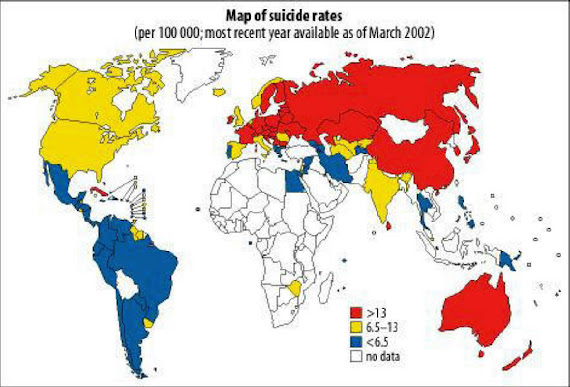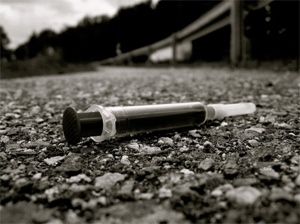Suicide Prevention
The mission of this blog is to help people stay away from suicide. We focus on suicide Prevention and we want people to know that LIFE is EVERYTHING!
Suicide Map

Fred Tiencken
Thursday, May 1, 2008
How to Cope with Depression
How to Cope with Depression
There is always hope as there is help available for depression.
Depression is a terrible affliction in our society. Approximately 16% of the population have suffered from depression at least once in their lives and it is expected that by the year 2020, it will be the second leading cause of disability behind heart disease. Although medications are often prescribed to treat depression, you may want to explore other options before taking this route. However, if you are currently suffering acutely, you should not feel as though you need to wait to seek a psychiatrist for a consultation.
Steps
1. Determine if you really are depressed, and what the problem is. Do you lack motivation? Do you have trouble enjoying things that you used to? Do you cry a lot? Does it seem that nothing is really worth doing? Do you feel that your life is meaningless? If so, it is possible that are sinking into the psychological quicksand of clinical depression.
2. Get plenty of sleep. In the modern world, there is an increasing problem of people not getting enough sleep. Practice good sleep hygiene and try to get around eight hours. Depression and anxiety of any sort can interfere with sleep, so this may or may not be possible.
3. Get out of bed in the morning. If this is something you are struggling with, ask a friend to call you in the morning to make sure you are awake.
4. Exercise. A recent study showed exercise to be as effective as Zoloft (a selective serotonin reuptake inhibitor or SSRI) in treating depression. Exercise is very good for body and mind. Depression can make it hard to work up the motivation and energy to do it, but it is well worth a try. You may find long walks easier than other forms of exercise - put one foot in front of the other, and walk as far as you are able. You might work up to even 1 or 2 hours every day, but start off with shorter walks. Even if you can only manage a few minutes to start, that is still a good starting point.
5. Watch your favorite comedy, talk with people who make you laugh, visit your childhood hangouts or do anything that helps you remember happier times.
6. Think about happy thoughts. Focus on the details.
7. Go out and do something you enjoy. Buy yourself something nice, get a new haircut, or eat a good meal.
8. To get your mind off your own problems try to think of some way (big or small) you can help someone else.
9. Meditate. Yoga is useful in fighting depression, and allows you to meet new people. In particular, Yoga Nidra is a form of meditation and relaxation that makes you feel better.
10. Talk to friends or anyone who will give you support. If you're feeling really down, have them make a list of your best qualities.
11. Find positive outlets and channels for your emotions: music, writing, whatever.
12. Don't compare yourself to other people. Compare yourself to you at your lowest point in the past and think about what's better now. Pat yourself on the back for it. If you think you're at your lowest point ever, then imagine one small thing (the tiniest thing you can think of) that you know you can make better. And then move on from there.
13. Don't obsess about it or be hard on yourself if you still feel depressed or aren't happy. Nothing's more depressing than being angry at yourself for being depressed.
14. Change your life. Often times depression results from a deep-rooted desire to be in a different situation than you are right now. If you don't like your parents, move out of your house. If you don't like your city, move to a different one. If you don't like your job, find a new one.
15. Avoid poisonous people. Although you may show your unhappiness by acting depressed, others may reveal it through negativity, treating others badly, exercising power over others, insulting others, etc. Also avoid other depressed people. Depression is contagious. It may be hard to find happy people who are willing to help you out of your funk, but it's worth it.
16. Seek counseling. High school counselors and University counselors are paid the same amount no matter how many people they see, so they have no incentive to keep you coming back to them.
17. Seek medical advice from a trusted family doctor if you have persistent depression. A doctor may prescribe an anti-depressant if appropriate. However, keep in mind that it may be more appropriate to seek the help of a psychiatrist, as family doctors are not as equipped to correctly diagnose and treat clinical depression, or to distinguish between it and disorders which may display similar symptoms but require different treatment.
18. Diet & Nutrion: Ensure that you are including in your diet healthy foods and proper liquids. Too often than not we either neglect eating all together when we are depressed as well as drinking fluids or we eat too much of our favorite manufactured, chemically engineered foods with no nutrional value as well as inadvertantly robbing us of our much needed nutrients to survive all the same with drinking too much of our favorite sodas, coffees, 'fake' juice like drinks or turning to alcohol to ease our depressed mood. The depressed person (testimony of personal experience) doesn't have to make drastic changes to their diet but just adding in a few will make a world of difference and the effects are amazingly positive and instantaneous. Add in some of your favorite fruits or salads. Try ice cold water with a bit of lemon if you have trouble drinking water. Even one glass of water is helpfull and istead of sodas try your favorite sports drink (i.e. Gatorade, Propel, etc.) these alone will replenish your lost electrolytes that your body must have and as mentioned earlier. The results will be instant and you'll be amazed wondering why you didn't do it sooner.
For much more information visit http://www.wikihow.com/Cope-with-Depression
10 reasons not to commit suicide
........
1. If you’re reading this, there is at least a small part in you that doesn’t want to die. Listen to it, and please read on.
2. Suicide is final – once it's done, there’s no changing your mind. Since you have even the slightest of doubts, you owe it to yourself to stay alive.
3. You can always kill yourself later, why not wait? Even if you wait just one day, you may find a reason not to kill yourself in the meantime.
4. If you’re feeling suicidal, you’re probably in more pain than you know how to handle. There are ways to reduce the pain, and ways to learn to deal with pain. You can learn both - either way things will get better.
5. Just because you’re feeling suicidal doesn’t mean you have to act on that feeling.
6. Consider this – if you’re trying to escape from the pain you are in and seek relief, suicide is not the answer. You cannot feel relief, or anything else for that matter, if you are dead. You must stay alive in order to feel the relief you seek.
7. Often when feeling suicidal you feel alone. You are not alone – you found us didn’t you? Turn to your family or friends or a priest or a rabbi – anyone that will listen. If you don’t know whom to turn to, use the links on the right-hand side of this page to find resources that can help.
8. By terminating your life right now, you terminate your future. Consider this – we create our own future. You have the power to create whatever future you wish for yourself. But you need to be alive in order to have that future.
9. If you’re sensitive enough to be in so much pain that you no longer want to live, you’re probably sensitive enough to care about, and want to help others. Maybe you don’t feel like helping anyone else right now, but why not help yourself? And perhaps by not killing yourself and overcoming your difficulties you can later help someone else who is in a similar situation.
Still with me? Good!
For more info: please visit http://www.the-bright-side.org/site/thebrightside/section/325
Wednesday, April 30, 2008
Wednesday, April 23, 2008
10 most common methods of suicide
Top 10 Common Methods of Suicide
10. Drowning
How it’s Done: Maybe a relationship tremor has caused you to rethink your life here on the planet, and the weight of it all has made you decide to drown yourself. Sometimes, driving or even convincing yourself to walk into a large body or water will do it, otherwise many perish in as little water as a slightly-filled bathtub.
Results From Failure: Oxygen deprivation can cause severe and permanent brain damage.
9. Electric Shock
How it’s Done: Sometimes the thought of continuing to live in a world inundated with problems and insurmountable issues results on one wanting to die by electric shock. Something as simple as jamming a utensil in a wall outlet, to the more notable dunking an appliance in an occupied bathtub, can result in death by electric shock.
Results From Failure: Deep burns from 500-1000 volts, ventricular fibrillation at 110-220 volts, and severe neurological damage.
8. Exsanguination
How it’s Done: Frequently the most obvious way to rapidly harm one’s self yet pass on relatively slowly, is to slit the wrists or the carotid, radial, ulnar, or femoral artery. Using a sharp implement is the easiest way to go. Razors or knives are popular. Contrary to popular belief, the effective method for this is not to cross the wrist, but to draw the blade up the forearm (as is evident in the photograph above). This is the same way Japanese perform Jigai (women) and Seppuku (men), although their’s is often for more spiritual purposes.
Results From Failure: Extreme loss of blood causing the heart to dramatically slow eventually depriving the brain of oxygen. Also, most often, deep scars and tissue damage.
7. Jumping
How it’s Done: Pondering the emptiness in one’s life can be a painful experience. Yet, when it all seems so overwhelming, you might decide to plummet from a significant height to your own death. Leaping from a building to the pavement below is quite lethal, and popular. However, romantics may choose to use a cliff over jagged rocks. Or bridges.
Results From Failure: Shattered femurs from impacting with water up to severe bodily harm from impacting with any solid surface.
6. Suffocation
How it’s Done: You’ve decided that your life is in disarray and you can no longer stand the pressure. One way to end it all is to encase your head in a plastic bag and asphyxiate yourself. Or, if you’re really ready to go, nitrogen or helium directly inhaled is useful.
Results From Failure: Turning back at the last minute before passing out can result in serious and long-lasting to permanent brain damage.
5. Carbon Monoxide Inhalation
How it’s Done: It’s all so difficult and the full weight of the world is seemingly square upon your shoulders. You’ve decided to go to the great beyond and you are going to lock yourself in a car, in a closed garage with the engine running and go to sleep. Or, if you have any appliance that puts of CO, that’ll do.
Results From Failure: CO molecules irreversibly attach themselves to human hemoglobin and the result is often fatal even if one backs out.
4. Poisoning
How it’s Done: Romeo and Juliet had it down when, once seeing the other presumably dead, the other fatally poisons himself. Taking a substance internally not meant to be done so can be considered poisoning: cleaners, industrial fluids, diazepam, cyanide, and the like.
Results From Failure: The toxic levels of poison required to kill one’s self are generally non-reversible. However, hospital staff can attempt it and often make one vomit or something similar. Lasting effects can include internal organ damage.
3. Hanging
How it’s Done: It’s all over. Nothing in life seems to make it worth living any more. You can acquire a length of rope and construct yourself a noose, which is, by the way, considered a deadly weapon if tied correctly. Once built, wrap one end securely around something high: a rafter or a ceiling fan, and leap, head fastened within the loop, from a chair. Or, if you’re short of rope, anything strong enough to support your weight from your neck can be employed.
Results From Failure: Brain damage from lack of oxygen, Often, failure to actually break your own neck may only yield strangulation and you can be saved, but damaged. Also, permanent rope burns or implement scarring can occur.
2. Drug / Alcohol Overdose
How it’s Done: The pressure and stress of daily routines has beaten you down for the final time. Within your medicine cabinet lies the answer to your extermination: prescription and over-the-counter meds. A huge mouthful can do you right in. Or, to speed along the process, couple your target pills with a few swigs of alcohol. Many of our favorite musicians have chosen this route. Even alcohol alone, in extreme excess can kill you.
Results From Failure: Severe to permanent organ failure if successful removal isn’t achieved, as well as impaired judgment. Often, clinical assistance is necessary if attempt is repeated.
1. Gun Shot
How it’s Done: One of the most often achieved forms of suicide is by gun shot. Generally a head shot is desired since its results are 99 percent effective, however a chest shot can be equally as devastating.
Results From Failure: Sometimes the blast isn’t enough to kill. In this case, severe to permanent bodily damage can occur as well as blood loss, organ and tissue damage, and brain damage.
listverse.comMiddle-aged suicide
Suicide on the rise for middle-aged Americans
Rates for adults ages 45-54 climbed to highest level in 25 years, CDC finds
ATLANTA - The suicide rate among middle-aged Americans has reached its highest point in at least 25 years, a new government report said Thursday.
The rate rose by about 20 percent between 1999 and 2004 for U.S. residents ages 45 through 54 — far outpacing increases among younger adults, the U.S. Centers for Disease Control and Prevention reported.
In 2004, there were 16.6 completed suicides per 100,000 people in that age group. That’s the highest it’s been since the CDC started tracking such rates, around 1980. The previous high was 16.5, in 1982.
Experts said they don’t know why the suicide rates are rising so dramatically in that age group, but believe it is an unrecognized tragedy.
The general public and government prevention programs tend to focus on suicide among teenagers, and many suicide researchers concentrate on the elderly, said Mark Kaplan, a suicide researcher at Portland State University.
“The middle-aged are often overlooked. These statistics should serve as a wake-up call,” Kaplan said.
Roughly 32,000 suicides occur each year — a figure that’s been holding relatively steady, according to the Suicide Prevention Action Network, an advocacy group.
Highest for middle-aged women
Experts believe suicides are under-reported. But reported rates tend to be highest among those who are in their 40s and 50s and among those 85 and older, according to CDC data.
The female suicide rates are highest in middle age. The rate for males — who account for the majority of suicides — peak after retirement, said Dr. Alex Crosby, a CDC epidemiologist.
Researchers looked at death certificate information for 1999 through 2004. Overall, they found a 5.5 percent increase during that time in deaths from homicides, suicides, traffic collisions and other injury incidents.
www.msnbc.msn.com
Self Help Suicide Prevention Tips
- The following are some ways to help you cope with suicidal feelings: Tell your therapist, a friend, a family member, or someone else who can help.
- Distance yourself from any means of suicide. If you are thinking of taking an overdose, give your medicines to someone who can give them to you one day at a time.
- Remove any dangerous objects or weapons from your home.
- Avoid alcohol and other drugs of abuse.
- Avoid doing things you're likely to fail at or find difficult until you're feeling better.
- Know what your present limits are and don't try to go beyond them until you feel better.
- Set realistic goals for yourself and work at them slowly, one step at a time.
- Make a written schedule for yourself every day and stick to it no matter what. Set priorities for the things that need to be done first.
- Cross things out on your schedule as you finish them. A written schedule gives you a sense of predictability and control. Crossing out tasks as you complete them gives a feeling of accomplishment.
- In your daily schedule don't forget to schedule at least two 30-minute periods for activities which in the past have given you some pleasure such as: listening to music, playing a musical instrument, meditating doing relaxation exercises, doing needlework, reading a book or magazine, taking a warm bath, sewing, writing, shopping, playing games, watching your favorite DVD or video, gardening, playing with your pet, participating in a hobby, taking a drive or a walk.
- Take care of your physical health. Eat a well-balanced diet. Don't skip meals. Get as much sleep as you need, and go out for one or two 30-minute walks each day.
- Make sure you spend at least 30-minutes a day in the sun. Bright light is good for everyone with depression, not just people with Seasonal Affective Disorder (SAD).
- You may not feel very social but make yourself talk to other people. Whether you talk about your feelings or about any other topic, reducing your social isolation is likely to be helpful.
- Remember that while it may feel as if it will never end, depression is not a permanent condition.
Source: www.psycom.org
More Funding for Suicide Prevention
"The New York State Legislature has allocated $1,000,000 to the New York State Office of Mental Health for services and expenses to support a public awareness and education campaign which will be specifically focused on suicide prevention among young Latina and elderly Asian women."
Hopefully with enough donations like this we can save many more lives.
Source:Suicide Prevention Resource Center
(http://www.sprc.org)











